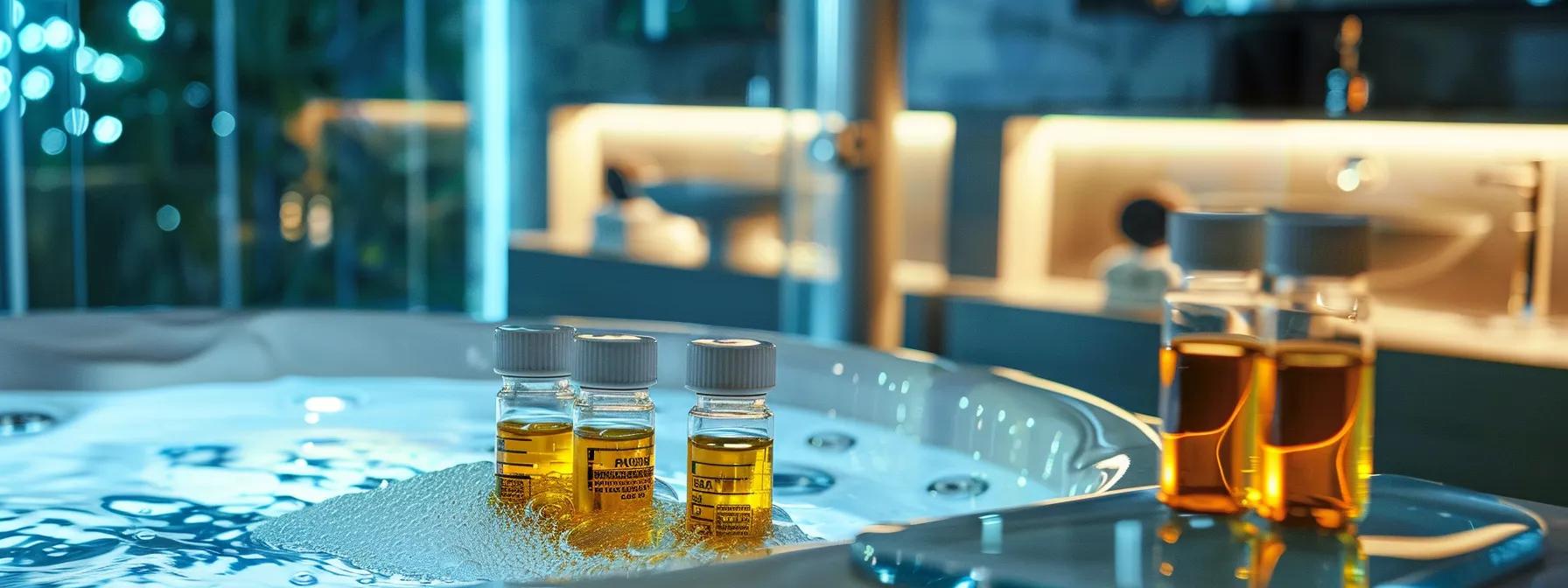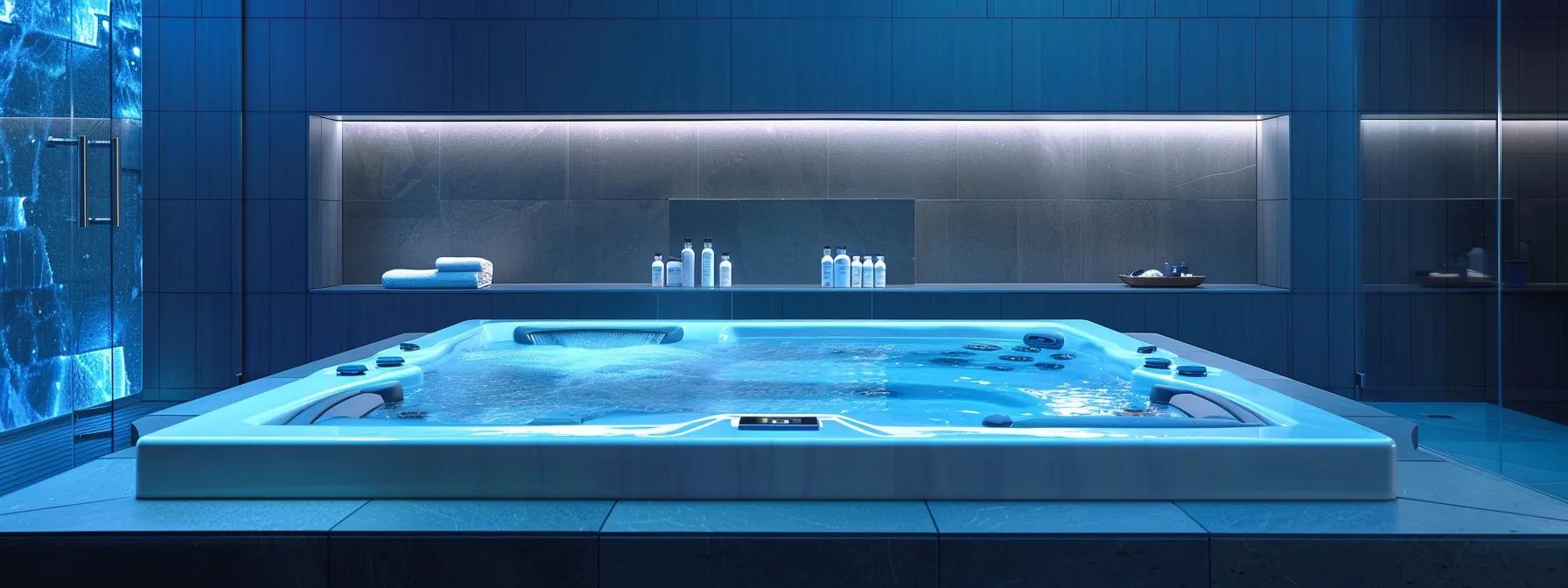Table of Contents - Expert Tips on Hot Tub Water Testing Kits for Care
- Understanding Why Regular Spa Water Analysis Is Paramount
- Identifying Critical Water Parameters Hot Tub Test Kits Measure
- Choosing the Right Hot Tub Water Testing Kit for Your Needs
- Performing Accurate Hot Tub Water Tests Step-by-Step
- Making Sense of Your Hot Tub Test Kit Readings
- The Role of Hot Tub Water Testing Kits in Sustained Spa Enjoyment and Safety
- Frequently Asked Questions
- Final Thoughts
This blog post may contain affiliate links. As an Amazon Associate I earn from qualifying purchases.
Hot Tub Water Testing Kits Explained for Optimal Care
Maintaining perfect water quality in your hot tub is essential for health, equipment longevity, and overall enjoyment. Incorporating water maintenance tips into your routine can make all the difference.
Over time, water chemistry can shift resulting in cloudy water, damaged components, or skin irritations. Regular water testing is the most effective way to prevent these issues; following a maintenance guide can further enhance your spa care.
In this article, we’ll explore why hot tub water testing kits are indispensable for ensuring clear, comfortable, and safe spa water by offering clear water tips to preserve its pristine condition.
We’ll cover how they work, the key parameters to measure, and best practices for maintaining your hot tub. Whether you’re a seasoned owner or new to hot tubs, understanding these tips will help you keep your spa in excellent shape.
Let’s get started by exploring why regular spa water analysis is paramount.
Understanding Why Regular Spa Water Analysis Is Paramount
Regular testing safeguards bather health and protects your hot tub’s components. Testing helps quickly identify harmful bacteria or contaminants and alerts you to chemical imbalances that can cause corrosion or scaling in pumps, heaters, and other parts.
By monitoring water chemistry, you can achieve clear, inviting water while keeping sanitizer levels effective. Using a test kit regularly preserves both equipment lifespan and a healthy soaking environment.
Safeguarding Bather Health Through Consistent Water Checks
Regular testing ensures disinfectants like chlorine or bromine remain at proper levels, reducing the chance of bacterial growth. Even minor chemical imbalances can lead to skin irritations or infections. By checking pH and sanitizer levels frequently, you prevent contamination and promote a safe spa environment for everyone.
Protecting Hot Tub Components From Damage
Chemical imbalances can lead to corrosion on metal parts and scale buildup on heaters and pipes. Consistent testing allows you to adjust chemical dosing promptly, keeping water neutral.
This proactive maintenance not only prevents expensive repairs but also ensures optimal performance of your pump and heater over the long term.
Achieving Crystal Clear and Comfortable Spa Water
Cloudy water often indicates imbalances in sanitizer levels or pH. By using a quality test kit, you can quickly spot and correct these issues. Clear, balanced water enhances your overall experience by preventing eye and skin irritations while ensuring that every soak feels refreshing.
Utilising hot tub water testing kits regularly ensures that you can maintain optimal water quality and safety.
Utilising hot tub water testing kits regularly ensures that you can maintain optimal water quality and safety.
Maintaining Effective Sanitizer Levels for Germ-Free Soaking
Sanitizers are the cornerstone of germ-free water. Factors like sunlight, temperature changes, or heavy use can reduce their effectiveness over time. A reliable test kit helps you monitor and maintain ideal sanitizer levels.
Ensuring that harmful pathogens are kept at bay and your hot tub water remains safe and inviting.
Implementing hot tub water testing kits is a vital part of routine maintenance for your spa.
Identifying Critical Water Parameters Hot Tub Test Kits Measure

Hot tub test kits assess several key metrics that determine water quality and safety. These include: • pH levels
The use of hot tub water testing kits can help prevent long-term damage to your hot tub.
• Total alkalinity
Regular usage of hot tub water testing kits will lead to a more enjoyable soaking experience.
• Sanitizer concentrations (chlorine or bromine)
Hot tub water testing kits provide essential data that allows you to maintain safe water conditions.
• Calciumhardness
• Total dissolved solids (TDS)
Always ensure that your hot tub water testing kits are up to date and reliable.
Each parameter plays a crucial role. pH and alkalinity affect both bather comfort and sanitizer efficiency, while sanitizer levels and calciumhardness protect against germs and scaling. TDS indicates overall “cleanliness” by revealing accumulated substances.
Assessing pH Levels for Bather Comfort and Sanitizer Efficacy
The ideal pH range for hot tub water is 7.2 to 7.8. This balance ensures comfort and maximizes sanitizer performance. Testing helps detect deviations that may lead to irritation or reduced chemical effectiveness, allowing for quick adjustments with pH increasers or decreasers.
Checking Total Alkalinity for pH Stability
Incorporating hot tub water testing kits into your routine is essential for maintaining water quality.
Total alkalinity acts as a buffer to stabilize pH levels. Maintaining alkalinity between 80 and 120 ppm ensures that the pH does not fluctuate dramatically. Consistent alkalinity prevents issues like scaling or corrosion by making pH adjustments more stable.
Verifying Sanitizer Concentrations Like Chlorine or Bromine
Test kits measure sanitizer levels to ensure they remain in the effective range—typically 1 to 3 ppm for chlorine and 3 to 5 ppm for bromine. Proper readings confirm that the water is germ-free, while adjustments prevent under- or over-sanitization, both of which can be problematic.
Measuring CalciumHardness to Prevent Scale or Corrosion
Calciumhardness should ideally be between 150 and 250 ppm. High levels can cause scale buildup that impairs heater efficiency, while low levels may lead to corrosion. Regular testing helps keep calcium levels within the optimal range, protecting both water clarity and equipment longevity.
Recognizing the Impact of Total Dissolved Solids
TDS indicates the presence of organic and inorganic materials accumulated in the water. High TDS levels can reduce sanitizer effectiveness and clarity. While not harmful by itself, monitoring TDS provides a good indication of when the water needs to be drained and refilled for balanced chemistry.
Choosing the Right Hot TubWater Testing Kit for Your Needs
There are several types of test kits available. The main options include test strips, liquidreagent kits, and digital testers; each has its own advantages.
Comparing Test Strips for Quick and Easy Checks
Test strips are favored for their ease and speed. Simply dip them in the water and compare the color change to a chart. They provide immediate results for key parameters like pH, alkalinity, and sanitizer levels. Although not as precise as other methods, they are ideal for routine checks when used properly.
Evaluating LiquidReagent Kits for Detailed Accuracy
Liquidreagent kits involve adding a reagent to a water sample and observing a color change. They typically provide more accurate results than test strips and can assess a broader range of parameters, including calciumhardness and TDS. While a bit more time-consuming, their detailed accuracy is valuable for precise chemical balance adjustments.
Considering Digital Testers for Precise Electronic Readings
Digital testers offer electronic readouts, minimizing human error. They tend to be more expensive but provide accurate measurements for pH, sanitizer levels, and sometimes TDS. For serious hot tub owners prioritizing precision and ease, a digital tester is a worthy investment.
Factors Influencing Your Spa Water Test Kit Selection
When choosing a test kit, consider ease of use, accuracy, frequency of testing, and budget. Busy owners might favor test strips for their speed, while those needing precise chemical adjustments may opt for liquid reagents or digital testers. Also, ensure that the kit covers the parameters most important for your hot tub’s maintenance.
To ensure your hot tub remains in top condition, utilise hot tub water testing kits regularly.
Performing Accurate Hot Tub Water Tests Step-by-Step

Once you’ve selected a test kit, proper testing technique is crucial for reliable results. Following a consistent procedure helps you identify trends and address issues early.
Collecting a Proper Water Sample for Reliable Results
Always collect water from a well-mixed area, avoiding stagnant spots or samples taken immediately after chemical additions. Use a clean container to prevent contamination and try to collect samples at the same time each day for consistency.
Following Test Strip Instructions Correctly for Readings
If you use test strips, follow the manufacturer’s instructions closely. Dip the strip for the recommended time and immediately compare the color changes against the provided chart. Good lighting and careful observation are key to avoid misreading the results.
Using Liquid Test Kits With Precision for Measurement
For liquidreagent kits, measure a precise volume of water and add the reagent as directed. Compare the resulting color change accurately with the chart. Precise measurement tools such as pipettes help ensure that the data you collect is reliable.
Calibrating and Utilizing Digital Water Testers Properly
Digital testers must be calibrated using a standard solution to maintain accuracy. After calibration, take direct readings from your hot tub water. Regular calibration and proper maintenance of the device help produce repeatable and precise measurements.
Common Mistakes to Sidestep During Water Testing
Avoid common pitfalls such as using outdated strips or reagents, sampling immediately after adding chemicals, or failing to calibrate digital devices. These mistakes can lead to erroneous readings and improper chemical adjustments. Adhering to the instructions and maintaining a consistent testing routine will help you manage your water chemistry effectively.
Making Sense of Your Hot Tub Test Kit Readings
Interpreting test kit readings is as important as taking accurate measurements. Compare your results with the ideal ranges to decide if adjustments are needed. Recognizing deviations early allows you to act quickly and maintain a safe spa environment.
The recommended range for hot tub water is generally:
- pH: 7.2–7.8
- Total alkalinity: 80–120 ppm
- Chlorine: 1–3 ppm or Bromine: 3–5 ppm
- Calcium hardness: 150–250 ppm
Knowing these ranges helps you establish a baseline for maintenance and determine when to adjust your chemical treatments.
Recognizing Ideal Ranges for Each Water QualityParameter
The recommended range for hot tub water is generally: • pH: 7.2–7.8 • Total alkalinity: 80–120 ppm • Chlorine: 1–3 ppm or Bromine: 3–5 ppm • Calcium hardness: 150–250 ppm
Knowing these ranges helps you establish a baseline for maintenance and determine when to adjust your chemical treatments.
What Low or High pH Readings Indicate for Your Spa
A pH below 7.2 indicates acidic water, which can irritate skin and damage components. A reading above 7.8 means water is too alkaline, potentially causing cloudy water and reducing sanitizer efficiency. Quick intervention with pH increasers or decreasers is necessary to restore balance.
Addressing Alkalinity Imbalances Effectively and Promptly
Low alkalinity can result in rapid pH drops, while high alkalinity makes pH adjustments difficult. Use test kit results to add the correct alkalinity increasers or reducers. Maintaining stable alkalinity minimizes frequent chemical corrections and supports overall water balance.
Adjusting Sanitizer Levels Based on Current Test Outcomes
If sanitizer levels fall below recommended ranges, add more chlorine or bromine. Conversely, too high levels may cause skin and eye irritation, requiring dilution or a waiting period before further adjustments. Regular measurement allows you to tailor your chemical treatment for safe, comfortable soaking.
Correcting CalciumHardness Issues in Your Hot Tub Water
If calcium levels are too high, scale may build up on surfaces and inside pipes, reducing efficiency. If too low, water may become corrosive. Adjusting hardness with appropriate additives keeps your system efficient and prolongs component life.
The Role of Hot Tub Water Testing Kits in Sustained Spa Enjoyment and Safety

Regular testing is key to a safe, comfortable, and visually appealing spa. By monitoring water chemistry, you reduce the need for excessive chemical adjustments, extend equipment life, and minimize health risks associated with unbalanced water.
Preventing Skin and Eye Irritation With Balanced Water Chemistry
Balanced water prevents common complaints like skin and eye irritation. When pH and sanitizer levels are maintained within ideal ranges, the water remains compatible with the human body, ensuring a comfortable soak every time.
Hot tub water testing kits are your best friend in achieving optimal water quality.
By understanding how to use hot tub water testing kits, you can maintain an inviting spa.
For a consistently pleasant experience, keep using hot tub water testing kits.
Hot tub water testing kits help maintain a consistently safe environment.
How Proactive Testing Minimizes Unnecessary Chemical Additions
Accurate test results help you avoid overusing chemicals. By making targeted adjustments rather than blanket treatments, you save resources and prevent further imbalances, promoting both sustainability and better water quality.
Extending the Operational Life of Your Hot Tub Equipment
Utilising hot tub water testing kits will safeguard your spa and its users.
Regular checks with hot tub water testing kits will help you enjoy your spa longer.
Hot tub water testing kits allow you to achieve the water quality needed for relaxation.
Ensuring your hot tub remains enjoyable involves regular hot tub water testing kits.
Proper water chemistry directly impacts the longevity of your hot tub’s components. Early detection of imbalances through regular testing allows you to take corrective action before significant damage occurs, saving on repairs and replacements.
Ensuring a Consistently Safe and Inviting Spa Atmosphere
Regular use of hot tub water testing kits ensures that you maintain a consistently safe and enjoyable spa environment.
The regular use of hot tub water testing kits creates a healthier soaking environment.
A well-maintained hot tub not only looks inviting but also assures users of its safety. Regular testing keeps the environment free of harmful pathogens and chemical irritants, enhancing the overall enjoyment of your spa.
Keeping a Log of Test Results for Superior Water Management
Recording test results over time helps identify trends and seasonal changes. A detailed log allows you to fine-tune chemical dosing more effectively, ensuring consistent water quality and reducing unexpected maintenance issues.
Frequently Asked Questions
Q: How often should I test my hot tubwater? A: Test your hot tub water at least 2-3 times per week, especially after heavy use or significant weather changes, to quickly detect and address any chemical imbalances.
Hot tub water testing kits are a straightforward way to check the balance of your water.
Regular use of hot tub water testing kits can prevent costly repairs down the line.
Q: Can I use a digital water tester instead of test strips? A: Yes. Digital water testers offer precise readings and reduce human error, though they require regular calibration. They are ideal for users prioritizing accuracy and convenience.
Q: What should I do if my test kit shows abnormal pH levels? A: Immediately adjust the pH using appropriate increasers or decreasers. Quick corrections help prevent skin irritations and equipment damage.
The importance of hot tub water testing kits cannot be overstated in maintaining a safe spa.
Q: How do total dissolved solids(TDS) affect water quality? A: Elevated TDS can make water cloudy and reduce sanitizer effectiveness. High TDS signals that it may be time to drain and refill your hot tub.
Utilising hot tub water testing kits allows you to enjoy your spa without worries.
Hot tub water testing kits help you adapt to changes in your water conditions effectively.
To maximise enjoyment, don’t forget to regularly use hot tub water testing kits.
Keeping your hot tub in excellent condition requires the use of hot tub water testing kits.
Q: Is it necessary to test for calciumhardnessoften? A: Yes. Regular testing of calcium hardness helps prevent scaling or corrosion. Keeping levels between 150 and 250 ppm protects your hot tub components.
Q: Can I mix different types of test kits for better accuracy? A: Absolutely. Many owners use test strips, liquid reagent kits, and digital testers together to cross-verify readings and ensure balanced water.
Q: Are there any environmental factors that affect hot tubwater quality? A: Yes. Temperature fluctuations, heavy use, and even nearby vegetation can influence chemical levels. Regular testing helps you adapt to changing conditions.
Final Thoughts
Maintaining optimal hot tubwater quality is the cornerstone of a safe and enjoyable spa experience. By regularly using a water testing kit, you can effectively manage your water’s chemical balance and protect your equipment.
This proactive approach not only extends the life of your hot tub’s components but also creates a clean, inviting environment. By following these routines and making informed adjustments based on accurate test readings, you’ll consistently enjoy a relaxing and trouble-free spa experience.
Utilising hot tub water testing kits is crucial in achieving the water quality needed for relaxation.



